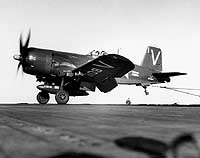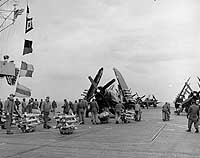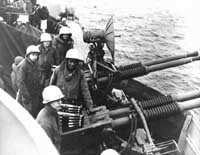
When the great Chinese offensive began on 25 November 1950, only the US fleet carriers Philippine Sea and Leyte remained with Task Force 77 in the combat zone. In accordance with the then-dominate Air Force doctrine, their planes were mainly flying interdiction missions immediately south of the Yalu River. Marine Corps aircraft, some based ashore and others on the escort carrier Badoeng Strait, were also present.
As the crisis developed, two more large carriers arrived, the recently recommissioned Princeton on 5 December and the urgently recalled Valley Forge later in the month. Also called in for the emergency were the British light carrier Theseus, U.S. escort carriers Sicily and Bairoko and light carrier Bataan. The latter two had just brought over the first Air Force F-86 swept-wing jets, badly needed to match the high-performance MiG-15s that were then making the Yalu area risky territory for other U.S. aircraft. The three smaller U.S. carriers provided mobile bases for some of the Marine Corps planes withdrawn from airfields in eastern North Korea. Theseus, aided at times by Bataan, Sicily, and Badoeng Strait, operated in the Yellow Sea to support the Eighth Army in western Korea.
On 1 December, the Marines' aircraft were freed from Fifth Air Force control. They and the Navy planes from Task Force 77 began to concentrate their efforts in support of the Chosin Reservoir campaign and other actions in the east. When weather permitted, they generated hundreds of sorties daily and were key elements in the success of the First Marine Division's fighting withdrawal from Chosin and the subsequent Hungnam Evacuation. Near Chosin on 4 December, a Leyte F4U pilot, LtJG Thomas Hudner, heroically attempted to rescue another flier, an act for which he became one of two Korean War Naval Aviators to receive the Medal of Honor. On Christmas Day 1950, when the safe completion of the Hungnam evacuation allowed a brief return to Japanese ports, Task Force 77 had been continuously at sea for fifty days.
The Chinese offensive also enhanced employment opportunities for Navy gun ships, which had earlier seen the war pass beyond their weapons' range. The battleship Missouri (BB-63); heavy cruisers Rochester (CA-124) and Saint Paul (CA-73); light cruisers Manchester (CL-83) and Juneau (CL-119), the British cruisers Kenya and Ceylon and many destroyers and other smaller ships were active in supporting UN and Korean ground forces and in providing escorts for Task Force 77's aircraft carriers. The latter mission, along with the continued presence of anti-submarine ships and aircraft and Navy submarines, was necessary to guard against the prospect of Soviet air and naval intervention in the conflict, threats that seemed all too real in the worrisome days of late 1950 and early 1951.
This page features pictures of and related to aircraft carrier and surface ship support during the Chinese offensive period of the Korean War, from 25 November 1950 to 25 January 1951.
For views of Naval gunfire support of the Hungnam evacuation
in December 1950, see: Hungnam Evacuation
-- Naval Gunfire Support.
For visual coverage of other aspects of the November 1950
- January 1951 Chinese offensive in Korea, see:
For a precis of our Korean War images, and links to more
comprehensive pictorial coverage of that conflict, see:
| If you want higher resolution reproductions than the Online Library's digital images, see: How to Obtain Photographic Reproductions. |
Click on the small photograph to prompt a larger view of the same image.
|
Photo #: 80-G-423961 Vought F4U-4B "Corsair" Fighter (Bureau # 62924) Landing on USS Philippine Sea (CV-47) after attacking targets in Korea, circa 7 December 1950. This plane belongs to Fighter Squadron 113 (VF-113). Official U.S. Navy Photograph, now in the collections of the National Archives. Online Image: 67KB; 740 x 610 pixels Reproductions of this image may also be available through the National Archives photographic reproduction system. |
 |
|
Photo #: NH 97059 USS Badoeng Strait (CVE-116) Navy and Marine Corps ordnancemen load 5-inch rockets and napalm on USMC F4U-4B "Corsair" fighter-bombers, during operations off Korea in December 1950. Official U.S. Navy Photograph, from the collections of the Naval Historical Center. Online Image: 73KB; 740 x 610 pixels |
 |
|
Photo #: 80-G-439880 USS Philippine Sea (CV-47) Plane handlers fueling a Grumman F9F-2 "Panther" jet fighter on the carrier's flight deck, 12 December 1950. Note metal ladder used to access the plane's wingtip fuel tanks. Official U.S. Navy Photograph, now in the collections of the National Archives. Online Image: 78KB; 590 x 765 pixels Reproductions of this image may also be available through the National Archives photographic reproduction system. |
 |
|
Photo #: 80-G-439888 Sikorski HO3S-1 helicopter, of squadron HU-1 Tipped over on the the flight deck, forward, of USS Philippine Sea (CV-47) after crashing on 9 January 1951. Note crewmen using a forklift and ropes in an attempt to pull the helicopter upright. Official U.S. Navy Photograph, now in the collections of the National Archives. Online Image: 61KB; 740 x 605 pixels Reproductions of this image may also be available through the National Archives photographic reproduction system. |
 |
|
Photo #: 80-G-439890 General Motors TBM-3E "Avenger" (Bureau Number 91404) Crashes into the barrier while landing on board USS Philippine Sea (CV-47), during operations in the Korean war zone on 17 January 1951. Note: details of the carrier's island, with a Le Tourneau crane parked nearby; splintered wooden decking below the plane; and hydraulic fluid spilling from the plane's port side landing gear leg (seen in the air just below and in front of the tailplane). Official U.S. Navy Photograph, now in the collections of the National Archives. Online Image: 103KB; 790 x 605 pixels Reproductions of this image may also be available through the National Archives photographic reproduction system. |
 |
|
Photo #: 80-G-426556 USS English (DD-696) A 40mm gun crew prepares to bombard enemy installations along the Korean coast, circa October 1950 - February 1951. Photograph was received by the Naval Photographic Center on 21 February 1951. Note radar antenna on this quad 40mm mount and ammunition loaded in guns. Another 40mm mount, pointed in the opposite direction, is in the upper left background. Official U.S. Navy Photograph, now in the collections of the National Archives. Online Image: 94KB; 740 x 600 pixels Reproductions of this image may also be available through the National Archives photographic reproduction system. |
 |
For views of Naval gunfire support of the Hungnam evacuation
in December 1950, see: Hungnam Evacuation
-- Naval Gunfire Support.
For visual coverage of other aspects of the November 1950
- January 1951 Chinese offensive in Korea, see:
For a precis of our Korean War images, and links to more
comprehensive pictorial coverage of that conflict, see:
| If you want higher resolution reproductions than the Online Library's digital images, see: How to Obtain Photographic Reproductions. |
New images added 24 September 2000